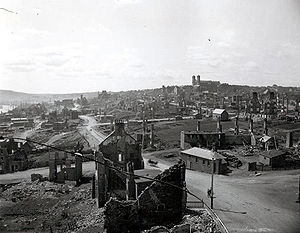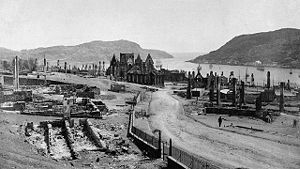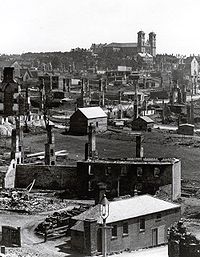
Great Fire of 1892
Encyclopedia

Fire
Fire is the rapid oxidation of a material in the chemical process of combustion, releasing heat, light, and various reaction products. Slower oxidative processes like rusting or digestion are not included by this definition....
in St. John's, Newfoundland and Labrador
St. John's, Newfoundland and Labrador
St. John's is the capital and largest city in Newfoundland and Labrador, and is the oldest English-founded city in North America. It is located on the eastern tip of the Avalon Peninsula on the island of Newfoundland. With a population of 192,326 as of July 1, 2010, the St...
on July 8, 1892, is remembered as the worst disaster ever to befall that city. Previous "Great Fire"s had occurred in St. John's in 1819 and 1846.
At approximately 4:45 in the afternoon on July 8, 1892, a dropped pipe in Timothy O'Brien's stable at Freshwater Road at the top of Carter's Hill began what would become the worst fire in St. John's history. Initially the fire did not cause any widespread panic, however a series of catastrophic coincidences caused the fire to spread and devour virtually all of the east end of the city, including much of its major commercial area before being extinguished.
Rev. Moses Harvey
Moses Harvey
Moses Harvey LL.D. clergyman, essayist and naturalist born Armagh, Ireland and died in St. John's, Newfoundland....
witnessed the initial stages of the fire and remarked to his friend that it "was a bad day for a fire. A high wind from the north-west was blowing, hurling the sparks far and wide on the roofs of the clusters of wooden houses. For a month previous hardly any rain had fallen, and the shingled roofs were like tinder." The situation was exacerbated because of work completed earlier in the day on the water mains
Water supply
Water supply is the provision of water by public utilities, commercial organisations, community endeavours or by individuals, usually via a system of pumps and pipes...
. Although water flow was re-established by 3 p.m., two hours before the fire began, water pressure was insufficient to force water up into the higher sections of the city where the fire began. W.J. Kent
W.J. Kent
William Joseph Kent was a business and political leader in Bathurst, New Brunswick in Canada. Kent's business enterprises were significant in the economic development of the region, and Kent was a founding alderman in Bathurst's first town council for sixteen years before serving as mayor of...
remarked that the "flames therefore made headway before water was procurable, and as a very high westerly wind was furiously fanning the fire it began to spread rapidly."

Cathedral of St. John the Baptist (St. John's)
The Cathedral of St. John the Baptist is located in the city of St. John's, Newfoundland. This parish in the Diocese of Eastern Newfoundland and Labrador was founded in 1699 in response to a petition drafted by the Anglican townsfolk of St. John's and sent to the Bishop of London, the Rt. Rev....
. The nave
Nave
In Romanesque and Gothic Christian abbey, cathedral basilica and church architecture, the nave is the central approach to the high altar, the main body of the church. "Nave" was probably suggested by the keel shape of its vaulting...
and transept
Transept
For the periodical go to The Transept.A transept is a transverse section, of any building, which lies across the main body of the building. In Christian churches, a transept is an area set crosswise to the nave in a cruciform building in Romanesque and Gothic Christian church architecture...
s of the church were filled with valuable property belonging to numerous families including that of the Anglican bishop
Bishop
A bishop is an ordained or consecrated member of the Christian clergy who is generally entrusted with a position of authority and oversight. Within the Catholic Church, Eastern Orthodox, Oriental Orthodox Churches, in the Assyrian Church of the East, in the Independent Catholic Churches, and in the...
of the day, Lleweyn Jones. Unfortunately the cathedral also fell victim to the ravenous fire. Kent described the burning of the cathedral as follows:
"with one fearful rush the demonic fire seized upon the doomed cathedral, and sooner than tongue could tell the immense edifice, a gem of Gothic architecture
Gothic architecture
Gothic architecture is a style of architecture that flourished during the high and late medieval period. It evolved from Romanesque architecture and was succeeded by Renaissance architecture....
, the masterpiece of Sir Gilbert Scott
George Gilbert Scott
Sir George Gilbert Scott was an English architect of the Victorian Age, chiefly associated with the design, building and renovation of churches, cathedrals and workhouses...
and the pride of every Newfoundlander, was a seething mass of flame. With a crash, heard even above the din of the elements the roof fell in, and the result of the labours and offerings of thousands for many years vanished in a cloud of smoke and dust."
The fire was far from finished; the wind caused offshoots of the main fire to consume new sections of the city while the main fire continued its destructive trek towards the city's commercial centre, Water Street
Water Street, St. John's
Water Street is located in downtown St. John's, Newfoundland and Labrador, Canada. It was developed in the early 16th century, and is the oldest street in North America. It became a commercial trading outpost for the Basques, French, Spanish, Portuguese, and English...
. The businesses that lined Water Street and Duckworth Street were destroyed as the fire spread throughout the downtown area. Rev. Harvey stated,
"The beautiful shops, full of valuable goods; the stores behind, containing thousands of barrels of flour and provisions of all kinds; the fish stores; the wharves, which it had cost immense sums to erect, -- disappeared one by one into the maw of the destroyer… the whole of Water Street, on both sides, was 'swept with the besom of destruction.'"
The fire continued to burn into the night and the early hours of the next morning. Rev. Harvey's description of the restless night stated that "the terror-stricken inhabitants flying before the destroyer,… the cries of weeping women hurrying with their children to places of safety -- all constituted a scene which not even the pen of Dante
Dante Alighieri
Durante degli Alighieri, mononymously referred to as Dante , was an Italian poet, prose writer, literary theorist, moral philosopher, and political thinker. He is best known for the monumental epic poem La commedia, later named La divina commedia ...
could describe." Similarly, Kent said of that night,
"All the arteries which led from the water to the higher portions of the town were crowded with the terrorised mob and the screams and cries of the women mingled with the wailing of children, the shouts intensified by the ever-freshening masses of livid fire and the glare of the burning buildings, contributed to make a scene the like of which it is not often given to the lot of many to witness…. Few there were who closed their eyes that night."
Daybreak on the morning of July 9, 1892 revealed the full extent of the fire's devastation. Kent described the sight of local residents viewing the desolation.

Rev. Harvey presents a similar description of the devastation and plight of the victims of the fire.
"The next morning I took a walk around the awful scene of devastation. It was heart-rending. Nothing visible for a mile from Devon Row but chimneys and fallen and tottering walls. The thick smoke, from the smouldering ruins still filled the air… The wrecks of the fanes of religion stood out, then [sic] broken walls pointing heavenward, as if in mournful protest against the desecration that had been wrought.
And the poor inhabitants, where were they? It made the heart ache to see the groups of men, women and children, with weary, blood-shot eyes and smoke begrimed faces, standing over their scraps of furniture and clothing -- some of them asleep on the ground from utter exhaustion -- all with despondency depicted on their faces. They filled the park and grounds around the city. Many hundreds escaped with nothing but the clothes they wore… At least twelve thousand people were burnt out."
Less than $5,000,000 of the total estimated losses of $13,000,000 were covered by insurance. A large influx of financial aid from Britain
United Kingdom of Great Britain and Ireland
The United Kingdom of Great Britain and Ireland was the formal name of the United Kingdom during the period when what is now the Republic of Ireland formed a part of it....
, Canada
Canada
Canada is a North American country consisting of ten provinces and three territories. Located in the northern part of the continent, it extends from the Atlantic Ocean in the east to the Pacific Ocean in the west, and northward into the Arctic Ocean...
and the United States
United States
The United States of America is a federal constitutional republic comprising fifty states and a federal district...
helped the city recover from its devastating losses.
It is from this reconstruction era that many of the present day registered heritage structures were either built or re-built. The most prominent architect of the reconstruction era in St. John's was John Thomas Southcott. He designed numerous Second Empire-styled buildings that had distinctive mansard roof
Mansard roof
A mansard or mansard roof is a four-sided gambrel-style hip roof characterized by two slopes on each of its sides with the lower slope at a steeper angle than the upper that is punctured by dormer windows. The roof creates an additional floor of habitable space, such as a garret...
s with bonnet-topped dormer
Dormer
A dormer is a structural element of a building that protrudes from the plane of a sloping roof surface. Dormers are used, either in original construction or as later additions, to create usable space in the roof of a building by adding headroom and usually also by enabling addition of windows.Often...
s protruding from the concave-curved roof surface. Southcott's prolific works were evidenced by the development of the term the "Southcott style" which became associated with the architecture in the re-built city. Each year in Southcott's honour the Newfoundland Historic Trust presents the Southcott Award for excellence in the restoration of heritage structures.
Sources
The original article was taken extensively from a booklet written by W. J. KentW.J. Kent
William Joseph Kent was a business and political leader in Bathurst, New Brunswick in Canada. Kent's business enterprises were significant in the economic development of the region, and Kent was a founding alderman in Bathurst's first town council for sixteen years before serving as mayor of...
in 1892 and an excerpt from another eyewitness to the disaster, Rev. Moses Harvey, as published in the internet version of the Encyclopedia of Newfoundland and Labrador.
External links
- Encyclopedia of Newfoundland and Labrador
- Paul Butler. 1892, a 2008 novel about the fire.
- Paul Butler. St. John's: City of Fire

